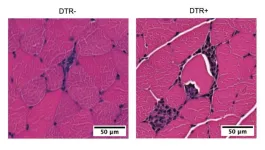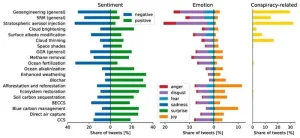(Press-News.org) The connection between exercise and inflammation has captivated the imagination of researchers ever since an early 20th-century study showed a spike of white cells in the blood of Boston marathon runners following the race.
Now, a new Harvard Medical School study published Nov. 3 in Science Immunology may offer a molecular explanation behind this century-old observation.
The study, done in mice, suggests that the beneficial effects of exercise may be driven, at least partly, by the immune system. It shows that muscle inflammation caused by exertion mobilizes inflammation-countering T cells, or Tregs, which enhance the muscles’ ability to use energy as fuel and improve overall exercise endurance.
Long known for their role in countering the aberrant inflammation linked to autoimmune diseases, Tregs now also emerge as key players in the body’s immune responses during exercise, the research team said.
“The immune system, and the T cell arm in particular, has a broad impact on tissue health that goes beyond protection against pathogens and controlling cancer. Our study demonstrates that the immune system exerts powerful effects inside the muscle during exercise,” said study senior investigator Diane Mathis, Morton Grove-Rasmussen Professor of Immunology in the Blavatnik Institute at HMS.
Mice are not people, and the findings remain to be replicated in further studies, the researchers cautioned. However, the study is an important step toward detailing the cellular and molecular changes that occur during exercise and confer health benefits.
Understanding the molecular underpinnings of exercise
Protecting from cardiovascular disease, reducing the risk of diabetes, shielding against dementia. The salutary effects of exercise are well established. But exactly how does exercise make us healthy? The question has intrigued researchers for a long time.
The new findings come amid intensifying efforts to understand the molecular underpinnings of exercises. Untangling the immune system’s involvement in this process is but one aspect of these research efforts.
“We’ve known for a long time that physical exertion causes inflammation, but we don’t fully understand the immune processes involved,” said study first author Kent Langston, a postdoctoral researcher in the Mathis lab. “Our study shows, at very high resolution, what T cells do at the site where exercise occurs, in the muscle.”
Most previous research on exercise physiology has focused on the role of various hormones released during exercise and their effects on different organs such as the heart and the lungs. The new study unravels the immunological cascade that unfolds inside the actual site of exertion — the muscle.
T cell heroes and inflammation-fueling villains
Exercise is known to cause temporary damage to the muscles, unleashing a cascade of inflammatory responses. It boosts the expression of genes that regulate muscle structure, metabolism, and the activity of mitochondria, the tiny powerhouses that fuel cell function. Mitochondria play a key role in exercise adaptation by helping cells meet the greater energy demand of exercise.
In the new study, the team analyzed what happens in cells taken from the hind-leg muscles of mice that ran on a treadmill once and animals that ran regularly. Then, the researchers compared them with muscle cells obtained from sedentary mice.
The muscle cells of the mice that ran on treadmills, whether once or regularly, showed classic signs of inflammation — greater activity in genes that regulate various metabolic processes and higher levels of chemicals that promote inflammation, including interferon.
Both groups had elevated levels of Treg cells in their muscles. Further analyses showed that in both groups, Tregs lowered exercise-induced inflammation. None of those changes were seen in the muscle cells of sedentary mice.
However, the metabolic and performance benefits of exercise were apparent only in the regular exercisers — the mice that had repeated bouts of running. In that group, Tregs not only subdued exertion-induced inflammation and muscle damage, but also altered muscle metabolism and muscle performance, the experiments showed. This finding aligns with well-established observations in humans that a single bout of exercise does not lead to significant improvements in performance and that regular activity over time is needed to yield benefits.
Further analyses confirmed that Tregs were, indeed, responsible for the broader benefits seen in regular exercisers. Animals that lacked Tregs had unrestrained muscle inflammation, marked by the rapid accumulation of inflammation-promoting cells in their hindleg muscles. Their muscle cells also had strikingly swollen mitochondria, a sign of metabolic abnormality.
More importantly, animals lacking Tregs did not adapt to increasing demands of exercise over time the way mice with intact Tregs did. They did not derive the same whole-body benefits from exercise and had diminished aerobic fitness.
These animals’ muscles also had excessive amounts of interferon, a known driver of inflammation. Further analyses revealed that interferon acts directly on muscle fibers to alter mitochondrial function and limit energy production. Blocking interferon prevented metabolic abnormalities and improved aerobic fitness in mice lacking Tregs.
“The villain here is interferon,” Langston said. “In the absence of guardian Tregs to counter it, interferon went on to cause uncontrolled damage.”
Interferon is known to promote chronic inflammation, a process that underlies many chronic diseases and age-related conditions and has become a tantalizing target for therapies aimed at reducing inflammation. Tregs have also captured the attention of scientists and industry as treatments for a range of immunologic conditions marked by abnormal inflammation.
The study findings provide a glimpse into the cellular innerworkings behind exercise’s anti-inflammatory effects and underscore its importance in harnessing the body’s own immune defenses, the researchers said.
There are efforts afoot to design interventions targeting Tregs in the context of specific immune-mediated diseases. And while immunologic conditions driven by aberrant inflammation require carefully calibrated therapies, exercise is yet another way to counter inflammation, the researchers said.
“Our research suggests that with exercise, we have a natural way to boost the body’s immune responses to reduce inflammation,” Mathis said. “We’ve only looked in the muscle, but it’s possible that exercise is boosting Treg activity elsewhere in the body as well.”
Authorship, funding, disclosures
Co-investigators included Yizhi Sun, Birgitta Ryback, Bruce Spiegelman, Amber Mueller, and Christophe Benoist.
The work was funded by National Institutes of Health grants R01 AR070334, F32 AG072874, and F32 AG069363; and by the JPB Foundation.
END
Some benefits of exercise stem from the immune system
Immune cells mobilized in the muscles during exercise fend off inflammation and boost endurance
2023-11-03
ELSE PRESS RELEASES FROM THIS DATE:
Seeing the unseen: How butterflies can help scientists detect cancer
2023-11-03
There are many creatures on our planet with more advanced senses than humans. Turtles can sense Earth’s magnetic field. Mantis shrimp can detect polarized light. Elephants can hear much lower frequencies than humans can. Butterflies can perceive a broader range of colors, including ultraviolet (UV) light.
Inspired by the enhanced visual system of the Papilio xuthus butterfly, a team of researchers have developed an imaging sensor capable of “seeing” into the UV range inaccessible to human eyes. The design of the sensor uses stacked photodiodes and perovskite nanocrystals (PNCs) capable of imaging different wavelengths ...
nTIDE October 2023 Jobs Report: People with disabilities maintain job gains as economy cools
2023-11-03
East Hanover, NJ – November 3, 2023 – Experts reported little change in October’s employment indicators, as people with disabilities extended their historic highs into the fall, according to today’s National Trends in Disability Employment (nTIDE) – semi-monthly update issued by Kessler Foundation and the University of New Hampshire’s Institute on Disability (UNH-IOD). As anti-inflationary measures exert their cooling effects on the economy, people with disabilities are striving to maintain their gains in the post-pandemic labor market.
Month-to-Month nTIDE Numbers (comparing September 2023 to October 2023)
Based on ...
Large herbivores such as elephants, bison and moose contribute to tree diversity
2023-11-03
Using global satellite data, a research team has mapped the tree cover of the world’s protected areas. The study shows that regions with abundant large herbivores in many settings have a more variable tree cover, which is expected to benefit biodiversity overall.
Maintaining species-rich and resilient ecosystems is key to preserving biodiversity and mitigating climate change. Here, megafauna – the part of the animal population in an area that is made up of the largest animals – plays an important role. In a new study published in the scientific journal One Earth, an international research team, of which Lund University is a part, has investigated the intricate interplay ...
The kids aren't alright: Saplings reveal how changing climate may undermine forests
2023-11-03
As climate scientist Don Falk was hiking through a forest, the old, green pines stretched overhead. But he had the feeling that something was missing. Then his eyes found it: a seedling, brittle and brown, overlooked because of its lifelessness. Once Falk's eyes found one, the others quickly fell into his awareness. An entire generation of young trees had died.
Falk – a professor in the UArizona School of Natural Resources and the Environment, with joint appointments in the Laboratory ...
Novel approach promises significant advance in treating autoimmune brain inflammation
2023-11-03
Researchers at DZNE and Charité - Universitätsmedizin Berlin have pioneered a novel treatment for the most common autoimmune encephalitis. By reprogramming white blood cells to target and eliminate disease-causing cells, the approach offers a new level of precision and efficiency. The technique has proven successful in laboratory studies, clinical trials in humans are already being planned.
NMDA receptor encephalitis is the most common form of antibody-caused brain disease, in which antibodies suddenly attack the brain, thus turning against the patient’s own body. “In ...
UC Santa Barbara researchers can now visualize osmotic pressure in living tissue
2023-11-03
In order to survive, organisms must control the pressure inside them, from the single-cell level to tissues and organs. Measuring these pressures in living cells and tissues in physiological conditions is a challenge.
In research that has its origin at UC Santa Barbara, scientists now at the Cluster of Excellence Physics of Life (PoL) at the Technical University in Dresden (TU Dresden), Germany, report in the journal Nature Communications a new technique to ‘visualize’ these pressures as organisms develop. These measurements can help understand how cells and tissues ...
A project that could touch all corners of Texas
2023-11-03
Texas is a huge state. And with that size comes soil diversity, supply chain delays, climate differences, material and labor costs and many other things to consider when evaluating the budget for a highway project.
To account for all of these variables, a University of Texas at Arlington researcher is building a price estimation and visualization tool for the Texas Department of Transportation (TxDOT) through a $200,000 U.S. Department of Transportation grant. Mohsen Shandashti, associate professor in the Department of Civil Engineering, is leading a team to develop that tool, which ...
Aston University 3D printing engineer wins Female Innovator of 2023 award
2023-11-03
Renia Gkountiou won the title of Female Innovator for 2023
She was nominated for her role in helping SMEs use and develop 3D printing
She is based at the Advanced Prototyping Facility which increases businesses’ awareness of 3D printing opportunities.
An Aston University engineer has been recognised at the 2023 Innovation Awards.
Renia Gkountiou who is as an engineer and technician within the University’s Advanced Prototyping Facility project won the title of Female Innovator for 2023.
She was nominated by professionals in her field for her role helping small to medium size businesses use ...
Aston University celebrates official opening of new city center HQ and launch of 2030 strategy
2023-11-03
The reception at John Cadbury House brought together more than 70 business leaders and other senior figures from across the city and region
The Mayor of the West Midlands, Andy Street, was guest speaker at the event
Professor Aleks Subic shared the University’s vision and ambitions for the future.
Aston University celebrated the official opening of its new Birmingham city centre headquarters and the launch of its 2030 strategy at a reception at John Cadbury House on Thursday 2 November.
The event, hosted by the University’s Vice-Chancellor and Chief Executive, Professor Aleks Subic, brought together more ...
Mother Nature knows best when it comes to climate solutions, social media users say
2023-11-03
People feel more positive about planting trees and protecting rainforests as a means of combating climate change than they do about employing technological solutions, according to a new research paper in Global Environmental Change.
A survey of more than a million social media posts suggests that people feel more positive about Nature's ability to solve climate change than human technology, according to new research published in the journal Global Environmental Change.
Researchers analysing 1.5 million posts on X (formerly Twitter) using the latest artificial intelligence-driven language models found expressions of “disgust” ...
LAST 30 PRESS RELEASES:
This self-powered eye tracker harnesses energy from blinking and is as comfortable as everyday glasses
Adverse prenatal exposures linked to higher rates of mental health issues, brain changes in adolescents
Restoring mitochondria shows promise for treating chronic nerve pain
Nature study identifies a molecular switch that controls transitions between single-celled and multicellular forms
USU chemists' CRISPR discovery could lead to single diagnostic test for COVID, flu, RSV
Early hominins from Morocco reveal an African lineage near the root of Homo sapiens
Small chimps, big risks: What chimps show us about our own behavior
We finally know how the most common types of planets are created
Thirty-year risk of cardiovascular disease among healthy women according to clinical thresholds of lipoprotein(a)
Yoga for opioid withdrawal and autonomic regulation
Gene therapy ‘switch’ may offer non-addictive pain relief
Study shows your genes determine how fast your DNA mutates with age
Common brain parasite can infect your immune cells. Here's why that's probably OK
International experts connect infections and aging through cellular senescence
An AI–DFT integrated framework accelerates materials discovery and design
Twist to reshape, shift to transform: Bilayer structure enables multifunctional imaging
CUNY Graduate Center and its academic partners awarded more than $1M by Google.org to advance statewide AI education through the Empire AI consortium
Mount Sinai Health system receives $8.5 million NIH grant renewal to advance research on long-term outcomes in children with congenital heart disease
Researchers develop treatment for advanced prostate cancer that could eliminate severe side effects
Keck Medicine of USC names Christian Pass chief financial officer
Inflatable fabric robotic arm picks apples
MD Anderson and SOPHiA GENETICS announce strategic collaboration to accelerate AI-driven precision oncology
Oil residues can travel over 5,000 miles on ocean debris, study finds
Korea University researchers discover that cholesterol-lowering drug can overcome chemotherapy resistance in triple-negative breast cancer
Ushikuvirus: A newly discovered giant virus may offer clues to the origin of life
Boosting the cell’s own cleanup
Movement matters: Light activity led to better survival in diabetes, heart, kidney disease
Method developed to identify best treatment combinations for glioblastoma based on unique cellular targets
Self-guided behavioral app helps children with epilepsy sleep earlier
Higher consumption of food preservatives is associated with an increased risk of type 2 diabetes
[Press-News.org] Some benefits of exercise stem from the immune systemImmune cells mobilized in the muscles during exercise fend off inflammation and boost endurance









